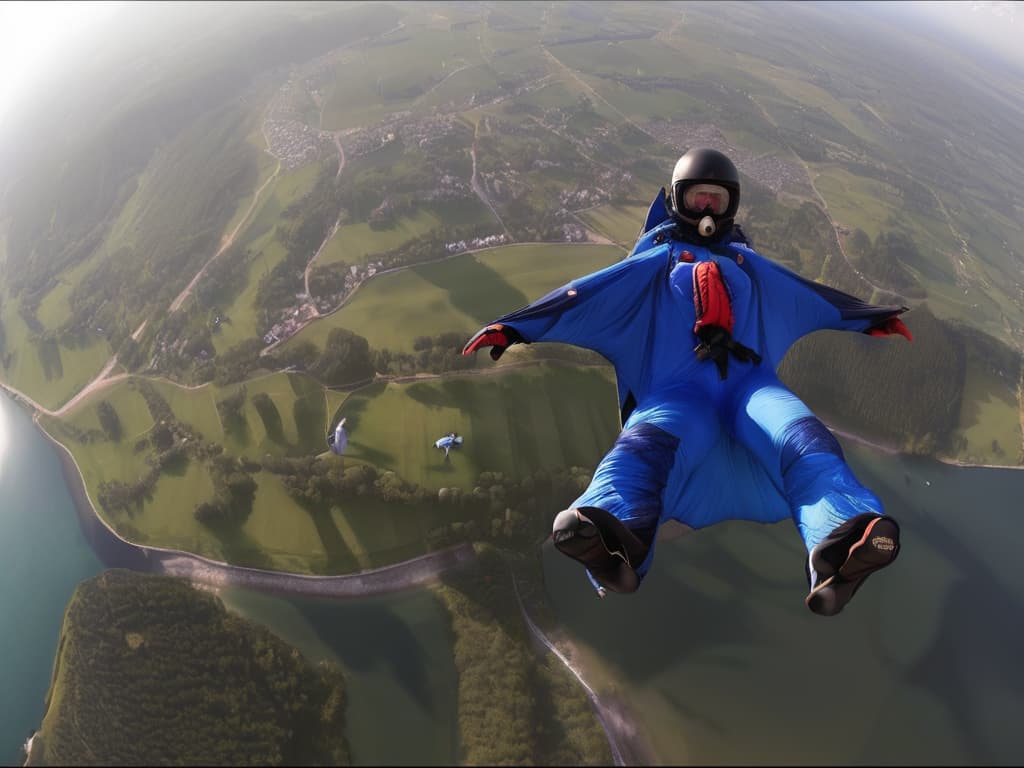Imagine flying through the sky in a fabric wing, gliding without effort. This is wingsuit flying, a thrilling sport for those who love adventure. It’s a journey that will test your skills and leave you amazed by human flight.
Wingsuit flying has a long history, starting in the early 20th century. Pioneers tested suits to fly like birds. Today, thanks to better technology, more people can enjoy this extreme sport.
This guide will help you start wingsuit flying. We’ll cover the basics of flying, safety, and rules. You’ll learn everything you need to begin this exciting aerial adventure.
Table of Contents
Understanding Wingsuit Flying Fundamentals

Learning to fly a wingsuit is all about understanding aerodynamic principles. As a beginner, knowing how wingsuits work and the key terms is key. It’s important for both success and safety.
Basic Aerodynamics and Flight Principles
The same aerodynamics that let birds fly apply to wingsuit flying. Wingsuits create lift, letting pilots glide and stay aloft. This reduces air sports safety risks. By using lift and controlling their body, pilots can fly fast and steer their path.
Essential Terminology for New Flyers
- Lift: The upward force that counteracts gravity, keeping the wingsuit flying.
- Drag: The air resistance the wingsuit faces, which can be lessened with good wingsuit design.
- Angle of Attack: The angle between the wingsuit and the wind, crucial for lift.
- Trim: The wingsuit’s balance and stability in flight, influenced by the pilot’s position.
How Wingsuits Work
Wingsuits use aerodynamics to offer a unique flying experience. The fabric wings, from arms to legs, act as airfoils, creating lift. By adjusting their body and angle of attack, pilots can fly through the sky, doing cool maneuvers and reaching high speeds.
“Wingsuit flying is exciting when you can grasp the fine balance between body control, drag, and lift. It’s a constant dance with the air, where every movement and decision can make the difference between a successful flight and a dangerous situation.”
Prerequisites for Wingsuit Flying: From Skydiving to First Flight
Learning to fly a wingsuit starts with a strong foundation in skydiving. You need to master skydiving before you can fly a wingsuit. This step-by-step process ensures your safety and prepares you for success.
The typical prerequisites for wingsuit flying include:
- Extensive Skydiving Experience: You need at least 200-300 successful skydives. This experience helps you develop the skills needed for wingsuit flying.
- Base Jumping Proficiency (Optional): While not required, base jumping experience is helpful. It prepares you for flying close to the ground.
- Specialized Training: You must get training from certified instructors before your first wingsuit flight. This training covers important topics like aerodynamics and emergency procedures.
Switching from skydiving to wingsuit flying is a big step. But with the right preparation and guidance, you can safely enjoy this thrilling sport.
| Requirement | Minimum Recommended |
|---|---|
| Skydiving Experience | 200-300 jumps |
| Base Jumping Experience | Optional, but beneficial |
| Specialized Wingsuit Training | Required from certified instructors |
Always put safety first when starting your wingsuit flying journey. By following these steps and getting advice from experts, you’ll be ready to master this exciting sport.
Essential Safety Measures and Regulations in Wingsuit Flying
Wingsuit flying is an exciting air sport that requires careful attention to safety. It’s important to know the key safety steps and rules to stay safe while enjoying this thrilling activity.
Safety Equipment and Gear Checks
Having the right gear is the first step to safe wingsuit flying. Always check your wingsuit, harness, parachute, and other important items before flying. Make sure all straps and connections are tight and replace any damaged parts right away.
Weather Considerations
Weather is a big factor in wingsuit flying. Look at the forecast, wind speeds, and cloud cover to make sure the weather is good for flying. Never fly in bad weather because it can be dangerous.
Emergency Procedures
Even with careful planning, emergencies can happen. Learn how to use your reserve parachute and how to control your flight in an emergency. Know how to land safely and always have a plan for a controlled descent.
Following safety rules and regulations is key to enjoying wingsuit flying safely. By focusing on your safety and being careful, you can have a great time in this exciting sport.
Choosing Your First Wingsuit: A Beginner’s Guide
Starting your wingsuit flying journey means picking the right suit first. The market is full of wingsuit manufacturers with various options. For beginners, focus on safety, stability, and ease of use in beginner wingsuit models.
When picking a beginner wingsuit, consider the design and wing size. Bigger wings give more lift and stability, perfect for newbies. Choose a suit with a large surface area and a gentle flight. This helps you learn without getting lost in tricky moves.
The suit’s build and materials are also key. Go for a sturdy, reliable suit from a known wingsuit manufacturer. Steer clear of low-quality suits that can risk your safety. The ideal suit fits well but doesn’t limit your movement, keeping you in control.
- Prioritize stability and predictability in a beginner wingsuit model
- Look for a suit with a generous wing surface area for added lift and control
- Invest in a high-quality suit from a trusted wingsuit manufacturer
- Ensure a proper, comfortable fit that allows for unrestricted movement
Choosing the right beginner wingsuit sets the stage for a safe and fun learning experience. By picking a suit that matches your skill and needs, you’re ready to dive into the exciting world of wingsuit flying.
Wingsuit Flying, Beginner Air Sports: Training Programs and Certification
Starting in the world of wingsuit flying needs the right training and certification. This ensures your safety and helps you get better. It’s important to find good instructors and understand the different levels of training.
Finding Qualified Instructors
For wingsuit training, having experienced instructors is key. Look for programs with qualified instructors who know a lot about teaching wingsuit flying. They can teach you a lot, give you hands-on practice, and give you a strong start.
Training Progression Levels
- Beginner wingsuit training: Teaches basic skills like body control, staying stable, and simple moves.
- Intermediate training: Adds to the basics, teaching more complex moves like turns, dives, and flying in groups.
- Advanced training: Prepares you for tough flying, like flying close to others, going fast, and doing complex tricks.
Certification Requirements
Good certification programs for wingsuit flying need you to know theory, practice, and show you can do different moves well. These certification programs make sure you can fly safely and enjoy it.
Getting the right wingsuit training and certifications is key for beginners. By focusing on safety and learning, you can really enjoy wingsuit flying. This way, you can have fun while staying safe.
Physical and Mental Preparation for Wingsuit Flying
Wingsuit flying is more than just technical skills. It also needs physical fitness and mental readiness. Let’s look at how to get your body and mind ready for this exciting sport.
Achieving Physical Fitness
Wingsuit flying is tough on your body. So, staying fit is key. Work on strength, flexibility, and heart health with a good training plan. Focus on exercises for your core, legs, and upper body. These muscles are crucial during flights.
- Strength training to develop muscular power and stability
- Flexibility exercises to enhance range of motion and agility
- Cardiovascular workouts to improve endurance and stamina
Mastering Mental Preparation
Mental readiness is as important as physical fitness in extreme sports like wingsuit flying. Learn to handle stress, stay focused, and keep a positive attitude. Use visualization, meditation, and mental rehearsal to help you.
“The most crucial aspect of training for any extreme activity is the mind.. Your physical skills are only as good as your mental game.”
By focusing on both physical and mental preparation, you’ll be ready to enjoy wingsuit flying safely. You’ll unlock your full potential and explore the thrill of this air sport.
Understanding Different Types of Wingsuit Jumps
Wingsuit flying offers many jump styles, each with its own thrill. You can try formation flying for precision or go for the rush of proximity flying and aerobatics. There’s something for everyone who loves to fly.
Formation Flying Basics
Formation flying is a key part of wingsuit flying. It’s about flying with others to make cool patterns in the sky. It takes great skill to work together and keep the formation perfect.
Solo Flight Techniques
Solo jumps let pilots show off their own style. They can glide smoothly or do crazy turns. It’s a chance to really show off your flying skills.
Distance and Speed Flying
For the biggest thrill, try proximity flying or distance/speed flying. These involve flying close to the ground and reaching high speeds. It’s all about control and staying focused.
No matter if you like flying with others, showing off solo, or going fast, wingsuit jumping has it all. It’s a world full of excitement for anyone who loves to fly.
Conclusion
Your wingsuit flying journey is just starting. With the right training and safety, you can dive into the world of extreme air sports. Remember the basics of aerodynamics and the need for good certification.
The journey might look tough, but the thrill of wingsuit flying is worth it. You’ll feel free and accomplished, whether flying solo or with friends. Stay focused and let your love for wingsuit flying take you higher.
With the right attitude and safety first, your wingsuit flying journey can change your life. It’s a chance to explore new heights and make your flying dreams come true. Start this adventure and see how far you can go in air sports.
FAQ
What is wingsuit flying, and what can I expect as a beginner?
Wingsuit flying is an extreme sport where you wear a special jumpsuit. This jumpsuit has fabric panels that let you glide and do cool aerial tricks. As a beginner, you’ll learn a lot through training, get better at skydiving, and learn about wingsuit flying.
What kind of prerequisites do I need to start wingsuit flying?
To start, you need lots of skydiving experience, usually 200 to 500 jumps. You’ll also need to take special courses, learn safety rules, and get the right gear.
What safety measures should I take when starting wingsuit flying?
Safety is key in wingsuit flying. Always wear the right safety gear, like a good parachute and helmet. Also, check the weather, plan your flight, and know what to do in emergencies.
How do I choose the right wingsuit for a beginner?
For beginners, pick a wingsuit that’s stable and easy to control. Look for ones with a bigger surface area and simple designs. These will help you fly better at first.
What kind of training and certification do I need for wingsuit flying?
Good training is crucial for wingsuit flying. Find qualified instructors for a detailed training program. This will cover theory and practice, including jumps, to get your certification.
How can I physically and mentally prepare for wingsuit flying?
Wingsuit flying needs you to be fit and mentally strong. Work on your strength, flexibility, and heart health. Also, learn to handle stress, stay alert, and keep a positive attitude while flying.
What are the different types of wingsuit jumps and maneuvers?
Wingsuit flying has many jump types and tricks, from solo flights to complex formations. As you get better, you can try different styles and improve your skills.
